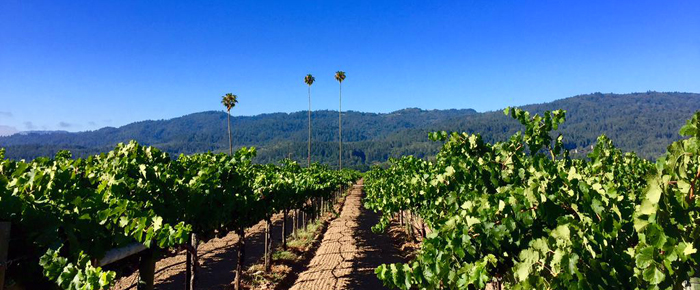
By Rick Riozza
Not too long ago, Merlot took a hit both in reputation and in sales as far as the in-vogue wine to enjoy. Merlot, “The little blackbird” in French, the darling of the new vinophiles (oenophiles) of the 80’s and 90’s, found mud on its face and the fans stopped ordering it, drinking instead Pinot Noir.
We all had fun with the 2004 movie, “Sideways,” where we wine lovers were treated to two characters, Miles and his soon-to-marry friend Jack, mix it up with wine, women, and song (the soundtrack is some stellar up-beat jazz that always plays well at wine tasting parties). And boy did the movie make waves in the wine consumption business. Out of the blue, wine nerd Miles apparently gleaned “real” wine gravitas when his praise for Pinot Noir caused sales to soar, while his disparaging rants against Merlot stopped lower-end Merlot dead in their tracks. Napa wine writer, Dan Berger, wrote: “and every winemaker who made merlot at the time probably had acid reflux for a month.”
It’s forever been referred to as the “Sideways effect” when Pinot Noir producers saw the demand and understandably raised their prices—and they’re relatively still up there. But we vino lovers are surely secure with the quaffs of our favorite varietals—no matter what the world is clanging for. And those who were fans of delicious Merlot were never affected.
And of course, the clever irony and inside joke in the movie is that Miles favorite wine that he’s been waiting for that special occasion to open is his 1961 Château Cheval Blanc. Well, Château Cheval Blanc, a “right bank Bordeaux in Saint-Émilion, is indeed a blend of Merlot with a good percentage of Cabernet Franc.
The economic truth however is that the movie did increase American red wine consumption. When examined by price, we saw that the negative effects of Merlot were confined mostly to the lower priced segment, under $10 per bottle, And truth be told, back then there was a lot of medium-to-low priced Merlot getting a little flabby, which has since been improved on!
But in the 1990s, it emerged from somewhere back in the pack to pass Cabernet Sauvignon as the top-selling red varietal wine in the United States by the turn of the millennium. In the glory years, wine industry analysts dubbed Merlot “the Silicon Valley grape” because it grew 20% or 30% year after year, just like the dot-com stocks.
As we mentioned earlier, Merlot is one of the five premiere grape varieties that go into the most famous red blend in the world—known as Bordeaux. What Merlot brings to the classic mix of Cabernet Sauvigon, Cab Frank, Petite Verdot, and Malbec is plenty of red berry fruit, silky tannins, higher alcohol and lower acidity levels; while, Cabernet Sauvignon is heavy on the black fruit, relishes tighter tannins and significant structure, and, often lower levels of alcohol than Merlot. The beauty of Bordeaux’s wines stem from the blend; it is in fact the blended synergy between the Cabernet Sauvignon and Merlot, well supported by Cabernet Franc, which brings the balance and elegance that have become synonymous with Bordeaux wine for centuries.
The new world also blends these grapes with great success. When all the classic aforementioned varietals are used, quite often the producer will label the wine as a “Meritage”. With not so much of a “French” pronunciation, but rather rhyming with the English word “heritage”—indeed, this developed term is supposedly the combination of both the word “heritage” and the word “merit”, indicating the respect and quality for the pioneering Bordeaux blend.
But as we well know, Merlot is definitely a star on its own with its independent existence as a varietal. And is also now competing with a long list of tantalizing wines from around the world—Australia, New Zealand, Spain and Argentina included. Nearly everyone agrees that the best Merlots are world class wines, and that brands with established reputations continue to command a following. Merlot remains a much bigger category than either Pinot Noir or Syrah.
Because Cabs and Merlots are often teammates and blended together, some wine enthusiasts tend to lose the distinction. If both wines are produced in the same manner from the same area, Cabernet Sauvignon will usually taste bolder because of its high tannin content. However, there are many bold Merlot wines out there. If you are looking for bolder Merlots, a good piece of advice is to look for Merlot from hillside estates. Wine grapes from hillside vineyards produce smaller grapes which make more intense and tannic wines.
The Cool Climate Regions (aka ‘old world’) produce Merlots with higher acidity and more subtle fruit flavors. Wines from cool climates tend to taste more savory than fruity. Hot Climate Regions (aka ‘new world’) produce wines with body and bolder fruit flavors. Wines from hot climates tend to have increased alcohol content and taste inherently sweeter.
Classic Merlot flavors are black cherries, plums, black currants/cassis, dark chocolate, strawberries, vanilla, blueberries, raspberries, smoke, spices, leather, licorice, meat. In cool climate, look for fresh cherries, plums vanilla; in warm climate you’ll find chocolate, cooked cherries, and prunes.
One of the most cherished Merlot vineyards in California wine country is the Three Palms Vineyards that is now owned by Duckhorn Vineyards. Describing the 83 acre site as ‘North America’s greatest Merlot vineyard’ and ‘the crown jewel of our estate program,’ Duckhorn, in 2011 acquired exclusive rights for all of the grapes at this legendary site and in 2014 took over responsibility for farming the property. Duckhorn has produced a Three Palms Merlot since its inaugural 1978 vintage selling back then at $12.5 per bottle. It now sells for around $100 a bottle. The perennial bucket-list wine!
I recently enjoyed this wine at a special Duckhorn tasting event held at the HYATT REGENCY INDIAN WELLS RESORT & SPA in Indian Wells. A very impressive venue—looking forward to more tastings there! Cheers!












































